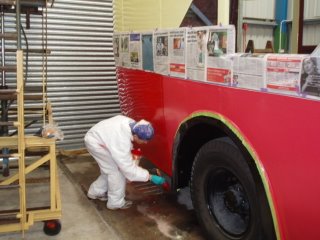
As the red and cream go onto the outside at last, after doing a myriad of small details inside and on loose components which will get fitted later, the realisation dawns that photos of pre-war buses in black and white simply do not do justice. The effect is dazzling. The sight of hundreds of these buses in red and cream on the city streets in the 1930s must have been quite uplifting.

MY FIRST BOO-BOO AS PAINT PROJECT MANAGER: I FORGOT THAT THE CREAM HAS TO COME DOWN SOME WAY ONTO THE REAR PLATFORM'S FRONT BULKHEAD. THIS HAS NOW BEEN RECTIFIED, AND BLACK LINES WILL BE APPLIED, CONTINUING AROUND FROM THE SIDE PANELS.

AT THE OTHER SIDE OF THE DOORWAY ROB APPLIES CREAM UNDERCOAT OVER THE RED SO PAINSTAKINGLY APPLIED ONLY A FEW DAYS AGO. The watering can is to apply water to the floor to keep dust down.

The same view of a bus newly bodied by Waddington, showing how the lines fit in. One difference is that as built, this bus has no conductor's box, which is the triangular door visible in its open position in the colour photos above. In the John Dunn book about Waddingtons/Comeng, this bus has been identified as number 629, a Leyland TD5 built in mid-1938. If you click on this photo to enlarge it, you can see that the entry way to the lower deck is not arched: it is the later angle-braced type.

WHILE ROB BEAVERS AWAY ABOVE, I TOOK THE OPPORTUNITY TO REMOVE THE TROUBLESOME VIBRATION DAMPER (THE LARGE ROUND THING AT LEFT). The damper itself proved to be fine; the looseness and severe vibration is from the flange mounted on the shaft coming out of the centre bearing (the smaller round thing to left of centre). Rather surprisingly this flange is splined onto the shaft, not mounted on a tapered section of shaft with a key to keep it rotating firmly on the shaft. All I could do was tighten up the retaining nut, now hidden back inside the damper, with a fat spring washer to discourage it from loosening until something can be done. Maybe an Albion drive flange, which does mount onto a keyed taper, can be used if the shaft coming out of the centre bearing can be ground to a taper and a keyway milled in.
September 29th:
(click on any photo to enlarge it)

The last three bays of red top coat go on the upper deck. Rob is wearing disposable paper overalls to minimise dust risk.

The red paint is beautiful stuff: as supplied to the London Transport Executive, it is that red used on the classic London bus, and is specifically for brushing. It dries more slowly than spraying enamel and gives the painter time to lay off or touch up as required. This can of red has been in stock for over fifteen years but has not deteriorated in any way.

The roof, the top deck windows, and the cream around the lower deck windows are all done. Now only the final coat has yet to go on the lower deck red panels, but after the long weekend (Labour Day), Rob will undertake the black lines which separate the bands of colour.

Before applying the red to the lower deck, Rob masks the cream above so that splashes from the brush do not mar the fresh paint.

Starting the final coat of red for the bottom deck; laying off vertically after making a heavy application of paint, spreading it horizontally, and going around the edges of the panel. In Rob's left hand is a small 1" brush to touch up around rivet heads, along the raised swages in the panels, and near the masking tape.






















